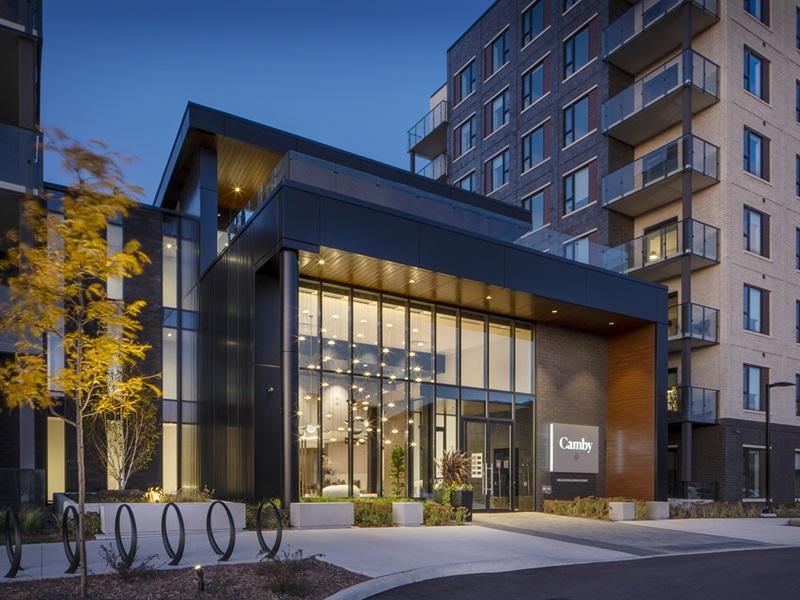
The Sumach, a seniors housing development in Toronto by Chartwell Retirement Residences. (Rendering courtesy Chartwell)
Quebec’s popular model of seniors housing can work elsewhere in Canada, but success will require a willingness on the part of municipalities to change their existing regulations.
That was one of the conclusions of a panel discussing how to export Quebec’s model of à la carte seniors housing during the Quebec Apartment Investment Conference on Feb. 12 in Montreal. Among experts in the sector, there is enthusiasm for the format.
“I think that the Quebec model is exactly what we need in Ontario,” said Angela Grottoli, vice-president, real estate integration at Chartwell Retirement Residences (CSH-UN-T).
The Quebec model, in which seniors pick and choose the majority of services they want, is unique in North America. It is generating increasing interest from major players in Canada, the U.S. and Europe, says Charles-André Latour, director, research, valuations and advisory at Altus Group in Montreal.
Quebec seniors homes have an average of between 250 and 350 units, compared to only 100 to 150 in Ontario.
À la carte units in Quebec generally have full kitchens with standard-size appliances. Newly built two-bedroom apartment rents average a base of $2,307 monthly.
Seniors housing vs. multi-residential
In Ontario, kitchens in units have small appliances, all services are included and rents average about $6,000 monthly for a new, two-bedroom apartment. Grottoli noted some Ontario municipalities allow seniors homes which do not have full kitchens in the units to have lower parking ratios, which reduces costs and property taxes.
“The minute you introduce full kitchens in units they consider you multi-residential, which increases your parking ratio,” she said. “In addition, your property taxes now fall under multi-res property taxes, which increase your operating costs.”
Chartwell is negotiating with some Ontario municipalities in the hope they will “shift their thinking a little bit” to lessen parking and tax requirements. This in turn will reduce development and operating costs for seniors housing.
Gaëtan Cormier, vice-president, international development at Groupe Sélection, says there is a large imbalance in seniors homes penetration between Quebec and Ontario: 17.9 per cent versus 5.5 per cent, respectively. Much of the difference lies in the affordability of the à la carte model.
Customer satisfaction rates are very high in Quebec, he said.
Under current penetration rates, Quebec will need an additional 50,000 units by 2028 to serve its aging demographic while Ontario will need an additional 32,000 units. However, if Ontario’s penetration rates reached the same as Quebec’s an additional 104,000 places would be required in seniors homes.
‘I believe that if we can attract younger seniors to our residences we can probably increase our penetration rate in Ontario,” Grottoli said. “Right now, price is an objection for a lot of people.”
Age-in-place is “next logical step”
However, if prices could be reduced by decreasing the number of services packaged with rental fees, Ontario could increase its penetration rate.
Canada’s population is aging and its current health care infrastructure will not be able to support a growing seniors demographic, she said: “The next logical step is to have that place for seniors who are younger to go and allow them to age in place.”
Given the high land costs in Ontario, Cormier said industry players are considering a multi-product or multi-generational approach with 250- to 350-unit properties. Of that total, 150 à la carte units would be for seniors and the other units would be for other uses.
Grottoli noted Chartwell is currently building a Quebec-model home in Ontario as “a real live pilot project.” Everything is à la carte in the 332-unit The Sumach at the corner of Shuter and Sumach Streets in Toronto’s Regent Park.
“We wanted to build it in an urban market because size matters (given development and land costs)”
The 12-storey building is about 50 per cent pre-leased and rents have increased along the way because demand has picked up.
“We expect to see good things. We think that this is step one,” with several other similar projects possible in Ontario.
Threat to à la carte model in Quebec
Meanwhile, the Quebec model of seniors homes is under threat in its home province, said Rita Kataroyan, vice-president, sales and marketing at seniors home operator Le Groupe Maurice.
The threat comes from Quebec’s rental board, the Régie du logement, which was created in the 1970s with the aim of protecting tenants from potential abuse by landlords.
However, Kataroyan noted, today’s popular multi-service seniors residences did not exist at the time. Seniors residences are now hard-pressed to raise workers’ pay, despite a tight job market, because of rent controls forced by the Régie.
Rent-fixing by the rental board takes little or no account of salaries, which easily make up half the operating costs of residences. The result is that smaller players are closing their doors because they’re no longer able to make a profit, while larger players might try to cut corners or reduce the quality of services.
Kataroyan said seniors homes operators have met with the new Quebec government about the issue and hope a solution can be found.







